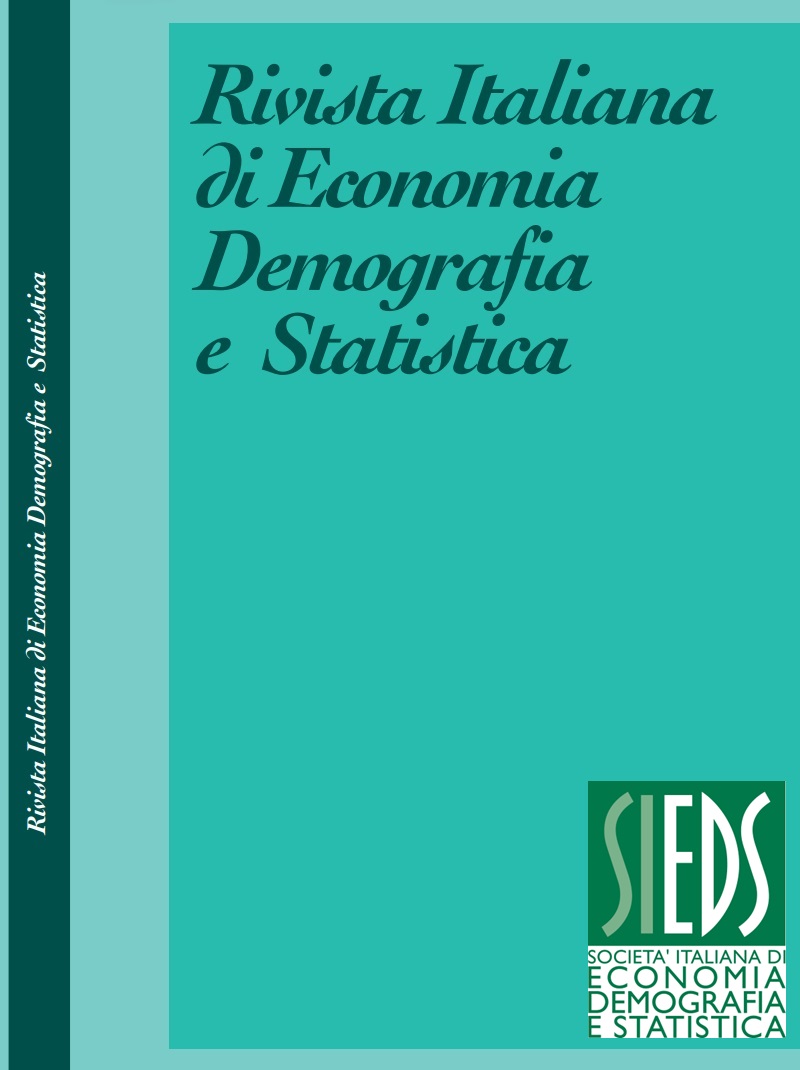Lifestyle, environmental conditions and mortality in European countries and in Italian regions
DOI:
https://doi.org/10.71014/sieds.v79i3.335Abstract
This paper uses state-of-the-art machine learning techniques to study the relationship between environmental pollution, life expectancy and lifestyle variables in European countries, with a focus on the Italian regions.
K-means clustering allowed to analyse the impact of the pandemic on socio-economic variables between 2019 and 2021, showing how countries position themselves with respect to these changes.
Different regional typologies were outlined, reflecting the diversity of environmental and health challenges.
Furthermore, a random forest analysis was used to predict life expectancy in European countries and Italian regions based on the presence of the most polluting and health-damaging substances.
This methodological approach offers new ways of identifying priorities for intervention, combining environmental mitigation with targeted prevention and treatment strategies.
References
BABU S, THOMAS B. 2023.A survey on air pollutant PM2.5 prediction using random forest model, Environmental Health Engineering and Management Journal, Vol. 10, No. 2, pp. 157–163 DOI: https://doi.org/10.34172/EHEM.2023.18
BALAKRISHNAN K., FULLER R., AND OTHER. 2022. Pollution and health: a progress update, The Lancet Health Review, Vol. 6, No. 6, e535-e547. DOI: https://doi.org/10.1016/S2542-5196(22)00090-0
BREIMAN L. 1996. Bagging predictors. Machine Learning. Vol. 24, pp. 123–140. Springer, Berlin/Heidelberg, Germany. DOI: https://doi.org/10.1007/BF00058655
BREIMAN L. 2001. Random forests, Machine Learning, pp. 5–32. DOI: https://doi.org/10.1023/A:1010933404324
DI LORENZO G., FEDERICO P., DE PLACIDO S., BUONERBA C. 2015 Increased risk of bladder cancer in critical areas at high pressure of pollution of the Campania region in Italy: a systematic review, Critical reviews in oncology/hematology, Vol. 96, pp. 534–541 DOI: https://doi.org/10.1016/j.critrevonc.2015.07.004
EUROPEAN ENVIRONMENT AGENCY 2019 Healthy Environment, healthy lives: how the Environment Influences Health in Europe, Report N. 21/2019
EUROPEAN ENVIRONMENT AGENCY 2023 Air Quality e-Reporting
GURURAJ T., VISHRUTHA Y. M., UMA M., RAJESHWARI D., RAMYA B. K. 2020. Prediction of Lung Cancer Risk using Random Forest Algorithm Based on Kaggle Data Set. International Journal of Recent Technology and Engineering (IJRTE), Vol. 8, No. 6, March 2020. ISSN: 2277-3878 (Online),
IARC 2022. https://monographs.iarc.who.int/agents-classified-by-the-iarc/
ISTAT 2022. Aspetti della vita quotidiana.
ISTAT 2021. Dati ambientali nelle città.
ISTAT 2021. Indagine sulle cause di morte.
ISTAT 2021. Indagine sui prodotti fitosanitari destinati all'uso agricolo.
JAIN A.K., DUBES RC. 1988. Algorithms for Clustering Data. Prentice-Hall, New Jersey.
JACKSON E.J.1991, A User’s guide to principal components, John Wiley &Sons, p.569. DOI: https://doi.org/10.1002/0471725331
KASSOMENOS, P., PETRAKIS M., SARIGIANNIS D., GOTTI A., KARAKITSIOS S. 2011. Identifying the contribution of physical and chemical stressors to the daily number of hospital admissions implementing an artificial neural network model, Air Quality, Atmosphere & Health, Vol, 4, pp. 263–272. DOI: https://doi.org/10.1007/s11869-011-0139-2
LIAW A., WIENER M. 2002. Classification and regression by random Forest, R News, Vol. 2 , No. 3, pp.18–22.
LIN Y.-C., TSAI C.-H., HSU H.-T., LIN C.-H. 2021. Using Machine Learning to Analyze and Predict the Relations Between Cardiovascular Disease Incidence, Extreme Temperature and Air Pollution. IEEE 3rd Eurasia Conference on Biomedical Engineering, Healthcare and Sustainability (ECBIOS), pp. 234–237. DOI: https://doi.org/10.1109/ECBIOS51820.2021.9510479
MARIEN L., VALIZADEH M., ZU CASTELL W., NAM C., RECHID D., SCHNEIDER A., MEISINGER C., LINSEISEN J., WOLF K., BOUWER L. 2022. Machine learning models to predict myocardial infarctions from past climatic and environmental conditions, Natural Hazards and Earth System Sciences, pp. 1–36. DOI: https://doi.org/10.5194/nhess-2021-389
PAVONE P., PAGLIACCI F., RUSSO M., RIGHI S., GIORGI A. 2021. Multidimensional clustering of EU regions. A contribution to orient public policies in reducing regional disparities, Social Indicators Research, April 2020. DOI: https://doi.org/10.1007/s11205-020-02324-9
PICKETT K. E, WILKINSON R. G. 2015. Income inequality and health: A causal review, Social Science & Medicine, Vol. 128, pp. 316-326. DOI: https://doi.org/10.1016/j.socscimed.2014.12.031
QUINLAN J.R. 1986. Introduction of decision trees, Machine Learning, Vol. 1 , pp. 81–106. DOI: https://doi.org/10.1007/BF00116251
SYAKUR M.A., KHOTIMAH B.K, ROCHMAN E.M.S, SATOTO B.D. 2018, Integration K-means clustering method and Elbow method for identification of the best customer profile cluster. In IOP conference series: materials science and engineering, Vol. 335, pp. 12-17. DOI: https://doi.org/10.1088/1757-899X/336/1/012017
Downloads
Published
Issue
Section
License
Copyright (c) 2025 Simona Cafieri, Gianmarco Borrata

This work is licensed under a Creative Commons Attribution 4.0 International License.



